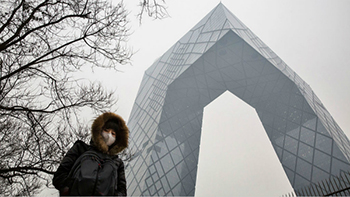
China’s state broadcaster CCTV, better known as a conduit for Beijing’s propaganda efforts, is aiming to grow an international network to carry its soap operas and news in Africa, the Middle East and the US.
官方的中国中央电视台(CCTV,该台更为人熟知的是角色是北京方面的宣传渠道)正力求发展一个国际网络,使该台的电视剧和新闻节目传播至非洲、中东和美国。
China International Communications Co (CICC), the commercial arm of China Central TV, streams Chinese content from CCTV and provincial broadcasters to overseas Chinese audiences — and is now setting its sights at non-Chinese audiences too.
中视国际传媒有限公司(CICC)是中央电视台的商业分支机构,该公司负责将该台和中国省级电视台制作的中文节目向海外华人观众直播。现在该公司也将目光对准了非华人观众。
“I want to make that content of CCTV localised, and want people to watch it for 5-10 minutes a week],” said Lu Chunguang, president of CICC. “Just 15 minutes of watching each means hundreds of millions [of viewer watching time].”
中视国际传媒总经理吕春光表示:“我希望把中央电视台的节目本地化,希望人们每周会看5到10分钟中央台。每人只看15分钟,这就是上亿分钟(的观看时间)。”
CICC has already set up a studio in Washington, hired 20 local news readers and begun broadcasting bulletins, initially focused on stock market information.
CICC已经在华盛顿建立一家工作室,聘用20名当地新闻播报员,开始播报新闻简报,最初将主要关注股市信息。
This builds on a business anchored in the overseas Chinese community. “Chinese like dramas, and we have more than 100,000 TV dramas produced every year,” said Mr Lu, speaking on the sidelines of last month’s Casbaa convention in Macau.
此举将以扎根于海外华人社区的业务为基础。在上月在澳门召开的亚洲有线及卫星电视广播协会(CASBAA)大会间隙,吕春光表示:“中国人喜欢看戏,我们每年制作的电视剧超过10万集。”
While Beijing has been ramping up its propaganda efforts overseas in recent years — including broadcasting videos on the South China Sea in New York’s Times Square over summer — analysts saw the move as a more subtle change of communication strategy.
尽管最近几年中国政府一直在提高对境外的宣传力度——包括今夏在纽约时代广场(Times Square)播放有关南中国海(South China Sea)的视频,但分析人士认为上述举动标志着沟通战略方面的更细腻变化。
“I think they are downplaying the ideological stuff when it comes to external publicity, they are putting more culture cards on the table,” said Qiao Mu, professor at Beijing Foreign Studies University.
北京外国语大学(Beijing Foreign Studies University)教授乔木表示:“我认为在对外宣传方面,他们正在淡化意识形态。他们正在打更多文化牌。”
“They are hoping overseas viewers can recognise and accept China, adding the economic co-operation and aids, to obtain other countries’ political recognition of China. One can say this is progress compared to their ideological preaching in the past.”
“他们希望海外观众能认可和接受中国,再加上经济上的合作和援助,从而获得其他国家对中国政治上的认可。可以说,比起过去的意识形态说教,这是一种进步。”
Last year, CICC started digitising its library of archived TV dramas in order to send more entertainment down the tubes.
去年,中视传媒开始将其电视剧库存数字化,以便通过各种渠道播放更多娱乐节目。
While many multinationals, from rice cooker manufacturers to luxury brands like LVMH, have been targeting Chinese tourists overseas for several years, immigrant populations have attracted less commercial attention.
尽管从电饭煲制造商到路威铭轩(LVMH)等奢侈品品牌,几年来许多跨国公司将营销目标对准了中国的海外游客,但中国移民人口吸引的商业注意力要少一些。
But Mr Lu says these groups — there are about 1m Chinese in Africa and 500,000 in the Middle East, and Chinese people comprise about 2 per cent of the US population and 2 to 3 per cent in Europe — represent a sizeable business.
不过,吕春光表示这些人群代表着十分可观的业务——非洲有大约100万华人,中东有50万华人,华人占美国人口比例约为2%、占欧洲人口比例为2%到3%。
“I bring over 30 networks to Los Angeles and people pay $15 a month to watch 30 TV channels, including some video-on-demand content. It’s very cost-effective: we send our oldest channels to an LA hub, and local system operators pick up our signal.”
“我把逾30个电视网络带到了洛杉矶,人们每个月花15美元收看30个电视频道,其中包括部分视频点播内容。整个过程的成本效益很好:我们将历史最悠久的频道发往洛杉矶一个转播中心,再由当地系统运营商接收我们的信号。”












